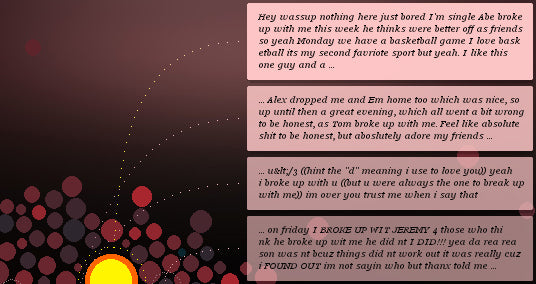The Dumpster, 2006
Interactive Java applet
Dimensions variable
About the Artwork
Launch The Dumpster by Golan Levin, Kamal Nigam & Jonathan Feinberg
|
The Dumpster is an interactive online visualisation that attempts to depict a slice through the romantic lives of American teenagers. Using real postings extracted from millions of online blogs, visitors to the project can surf through tens of thousands of specific romantic relationships in which one person has "dumped" another. The project's graphical tools reveal the astonishing similarities, unique differences, and underlying patterns of these failed relationships, providing both peculiarly analytic and sympathetically intimate perspectives onto the diversity of global romantic pain. The Dumpster was created by Golan Levin, Kamal Nigam and Jonathan Feinberg and made possible by support from the Whitney Artport, the Tate Online, and Intelliseek. Version 1.0 of the Dumpster was built in Processing and launched on Valentine's day, 2006. The Dumpster is the first in a series of three Net-based artworks co-commissioned by the Whitney Artport and the Tate Online. Critical texts and video interviews with the artists will accompany the works at the Tate Online web site. A high-resolution press image of the Dumpster can be found here. An essay about the Dumpster by media critic/historian Lev Manovich appears here. |
|
Where did the breakup data come from? The Dumpster visualizes a fixed collection of 20,000 romantic breakups that occurred during 2005. These breakups were obtained from web logs ("blogs") posted by people on the Internet. At least half of the authors of these breakups were American teenagers between the ages of 13 and 19. Approxmately seventy percent of the breakup authors were identified as female, while roughly fifteen percent were identified as male. The breakup data for the Dumpster was kindly provided by Intelliseek, the company behind BlogPulse. Blog posts were collected by issuing queries to BlogPulse's search engine using words and phrases indicative of breakups. For example, posts containing phrases such as "broke up" or "dumped me" were considered likely initial candidates. The resulting several hundred thousand posts were scored by a machine learning classifier trained to recognize posts about specifically romantic breakups, in an effort to eliminate (for example) posts about rock bands breaking up. From the remainder, the twenty thousand posts with the highest classification scores were selected for inclusion in the interactive visualisation. Using custom language-analysis software, the text of each post was computationally evaluated in order to determine many different characteristics of the breakup and the just-ended relationship. These included factual characteristics (e.g. was someone in the relationship cheating? Did the author instigate the breakup, or did the author's partner?), emotional characteristics (e.g. does the author appear to be angry, depressed, or relieved?), and other common features of romantic breakups (e.g. was this a "repeat breakup"? Have the former partners decided to remain friends?). Where possible, the age and gender of the author of the post were extracted and/or determined. All of these characteristics are then used as a means for computing and indicating the "similarity" of breakups within the interactive interface. |
About Golan Levin
Golan Levin (b. 1972) is a Pittsburgh-based artist and educator, active in software art since 1995. His work explores intersections of machine code, visual culture, and critical making to highlight our relationship with machines and expand human creativity. Levin’s art is in the permanent collections of the Museum of Modern Art, Tate London, ZKM Karlsruhe, and the Cooper-Hewitt Smithsonian Design Museum, and has been exhibited at venues like the Whitney Biennial, Victoria and Albert Museum, Ars Electronica, and ICA London. He holds degrees from MIT and has been a Professor of electronic art at Carnegie Mellon University since 2004. With Tega Brain, he co-authored Code as Creative Medium (MIT Press, 2021), a guide for creative coding educators.



